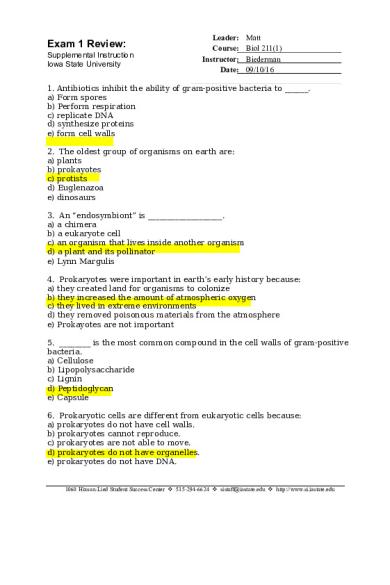Exam 1 review PDF

| Title | Exam 1 review |
|---|---|
| Author | Grant Nickles |
| Course | Principles of Biology I |
| Institution | Iowa State University |
| Pages | 5 |
| File Size | 209 KB |
| File Type | |
| Total Downloads | 85 |
| Total Views | 120 |
Summary
SI instructor made review for the exam. Is helpful to study off of, and gives a good idea at the level of questions asked on the exams....
Description
Exam 1 Review: Supplemental Instruction Iowa State University
Leader: Course: Instructor: Date:
Matt Biol 211(1) Biederman 09/10/16
1. Antibiotics inhibit the ability of gram-positive bacteria to ______. a) Form spores b) Perform respiration c) replicate DNA d) synthesize proteins e) form cell walls 2. The oldest group of organisms on earth are: a) plants b) prokayotes c) protists d) Euglenazoa e) dinosaurs 3. An “endosymbiont” is ___________________. a) a chimera b) a eukaryote cell c) an organism that lives inside another organism d) a plant and its pollinator e) Lynn Margulis 4. Prokaryotes were important in earth’s early history because: a) they created land for organisms to colonize b) they increased the amount of atmospheric oxygen c) they lived in extreme environments d) they removed poisonous materials from the atmosphere e) Prokayotes are not important 5. ________ is the most common compound in the cell walls of gram-positive bacteria. a) Cellulose b) Lipopolysaccharide c) Lignin d) Peptidoglycan e) Capsule 6. Prokaryotic cells are different from eukaryotic cells because: a) prokaryotes do not have cell walls. b) prokaryotes cannot reproduce. c) prokaryotes are not able to move. d) prokaryotes do not have organelles. e) prokaryotes do not have DNA.
1060 Hixson-Lied Student Success Center v 515-294-6624 v [email protected] v http://www.si.iastate.edu
7. All protists are ________. a) multicellular b) autotrophs c) marine d) parasitic e) eukaryotic 8. The disease ________ is caused by ________ and it transmitted by the ________ vector. a) malaria, Plasmodium, mosquito b) sleeping sickness, Trypanosoma, mosquito c) malaria, Plasmodium, tsetse fly d) chagas, Trypanosoma, mosquito e) chagas, Plasmodium, tsetse fly
Overview:
Cellular Live-Oxygen Revolution-Nucleated Cells-MulitcellularityCambrian Explosion
How did Eukaryotic cells come about: endosymbiosis 0 o -> Co -> O
The ____endosymbiont_____________ Theory: a result of this process? Eukaryotic cells
1. Label the 5 parts of the timeline presented by Dr. Biederman. - What organisms existed 3.5 billion years ago? What is their importance? What would these organisms likely look like under a microscope?
Which organelles were
Prokaryotes vs. Eukaryotes: What are the 3 Domains of life: (Circle the Prokaryotic Domain(s).) 1.Eukaryote
2.Bacteria
3. Archaea
Contrast: (Think about- DNA, Reproduction, organelles, size, motility, histone proteins, and examples of organisms from class)
Prokaryote Cells
Eukaryote Cells
Review: Compare and Contrast: Which domain does this apply to? How do you know? bacteria Gram (+) Gram (-)
How can you help stop the spread of antibiotic resistance genes?
Can a bacterial species be both good and bad for human health? How else do we benefit from bacteria? Yes, if a strand is pathogenic that doesn’t mean all of its species are harmful. Microbiome.
Protists: What are common features of all/most protists? (Think about which domain they are in? Lifestyle?) Eukaryotes
Reproduction: Prokaryote
Eukaryote
Processes Involved Resulting Cells
Benefits
What type of cell division is used for Eukaryotic tissue growth? Which process is this similar to and why? How can Prokaryotes get genetic diversity?
Fungi: Are fungi more closely related to animals or plants? How do they obtain food? What is the significance of this?
Cell Wall Composition:
Describe the function of each structure and label on the image. Hyphae-
Structure:
Look at your notes. Determine what is MOST relevant and distinguishable about each phyla. (12 things each) Chytridiomycota -aquatic -kills sea life
Glomeromycota -90% of plants
Zygomycota
Basidiomycota
Ascomycota
What are some symbiotic relationships from the groups above? How does each side benefit?...
Similar Free PDFs

Exam 1 review guide
- 8 Pages

Exam 1 Review Notes
- 10 Pages

Exam 1 review questions
- 28 Pages

Unit 1 Exam Review
- 4 Pages

MAR3023 Exam 1 Review
- 4 Pages

Biology Exam Review 1
- 3 Pages

DB Exam 1 Review
- 7 Pages

Exam 1 Review Sheet
- 10 Pages

Syg Exam 1 Review
- 29 Pages

Exam 1 Review Answers
- 1 Pages

BIO223 Exam 1 Review
- 5 Pages

Exam 1 Review F18
- 1 Pages

Exam 1 Review Complex
- 13 Pages

Accounting Exam 1 Review
- 3 Pages

Epidemiology Exam 1 Review
- 7 Pages

Exam 1 Review Completed
- 10 Pages
Popular Institutions
- Tinajero National High School - Annex
- Politeknik Caltex Riau
- Yokohama City University
- SGT University
- University of Al-Qadisiyah
- Divine Word College of Vigan
- Techniek College Rotterdam
- Universidade de Santiago
- Universiti Teknologi MARA Cawangan Johor Kampus Pasir Gudang
- Poltekkes Kemenkes Yogyakarta
- Baguio City National High School
- Colegio san marcos
- preparatoria uno
- Centro de Bachillerato Tecnológico Industrial y de Servicios No. 107
- Dalian Maritime University
- Quang Trung Secondary School
- Colegio Tecnológico en Informática
- Corporación Regional de Educación Superior
- Grupo CEDVA
- Dar Al Uloom University
- Centro de Estudios Preuniversitarios de la Universidad Nacional de Ingeniería
- 上智大学
- Aakash International School, Nuna Majara
- San Felipe Neri Catholic School
- Kang Chiao International School - New Taipei City
- Misamis Occidental National High School
- Institución Educativa Escuela Normal Juan Ladrilleros
- Kolehiyo ng Pantukan
- Batanes State College
- Instituto Continental
- Sekolah Menengah Kejuruan Kesehatan Kaltara (Tarakan)
- Colegio de La Inmaculada Concepcion - Cebu